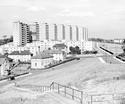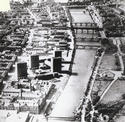 Tall blocks were first erected as part of "mixed development" (low and high rise) in some of the twenty-nine CDAs (Comprehensive Development Areas) identified as containing the worst slums. The most significant of these was Hutchesontown/Gorbals and this work was allocated to some world-renowned designers. One site (Area A, 1956) was rebuilt using four-storey, tenement-scale maisonettes. Area B was allocated to Sir Robert Matthew (1958-1964); Area C to Sir Basil Spence (1960-1966); and Area D (1961-1968) to the experimental state agency, the Scottish Special Housing Association. The large flats had enormous balconies, the size of small gardens. This was to be a garden suburb in the sky.
Tall blocks were first erected as part of "mixed development" (low and high rise) in some of the twenty-nine CDAs (Comprehensive Development Areas) identified as containing the worst slums. The most significant of these was Hutchesontown/Gorbals and this work was allocated to some world-renowned designers. One site (Area A, 1956) was rebuilt using four-storey, tenement-scale maisonettes. Area B was allocated to Sir Robert Matthew (1958-1964); Area C to Sir Basil Spence (1960-1966); and Area D (1961-1968) to the experimental state agency, the Scottish Special Housing Association. The large flats had enormous balconies, the size of small gardens. This was to be a garden suburb in the sky.
 Through the CDAs a full-scale motorway, the Glasgow Inner Ring Road, was to be threaded. The road resembled an American "parkway", loosened up to create a swathe of free-flowing greenery in, and through, the city. The objective of the designers was to create a "linear park" in the dense grid of Central Glasgow.
Through the CDAs a full-scale motorway, the Glasgow Inner Ring Road, was to be threaded. The road resembled an American "parkway", loosened up to create a swathe of free-flowing greenery in, and through, the city. The objective of the designers was to create a "linear park" in the dense grid of Central Glasgow.
 The climax was quite awesome, but not a "scheme" as such: a colossal group of steel-framed tower and slab blocks designed by Sam Bunton and built by the City's direct labour at Red Road, Balornock (1962-1969). The policy was to build high where the land became available. In a few short years of astonishing endeavour, Glasgow had solved its housing crisis.
The climax was quite awesome, but not a "scheme" as such: a colossal group of steel-framed tower and slab blocks designed by Sam Bunton and built by the City's direct labour at Red Road, Balornock (1962-1969). The policy was to build high where the land became available. In a few short years of astonishing endeavour, Glasgow had solved its housing crisis.
 Many questions have since been raised, despite the astonishing success of Glasgow's schemes in terms of providing sheer numbers of new houses. Glasgow's re-housers were serious about what they did. They believed in Glasgow and set about replacing its worst slums with modern houses, set in open landscaped areas to maximise the beneficial effects of space and light. Politicians, served by business, not business served by politicians, marshalled the effort. For all the well-publicised "failure" of 1960s planning, the experience of the 1970s and 1980s when there was a vacuum in urban planning showed that our cities are far too precious to be left to speculators alone.
Many questions have since been raised, despite the astonishing success of Glasgow's schemes in terms of providing sheer numbers of new houses. Glasgow's re-housers were serious about what they did. They believed in Glasgow and set about replacing its worst slums with modern houses, set in open landscaped areas to maximise the beneficial effects of space and light. Politicians, served by business, not business served by politicians, marshalled the effort. For all the well-publicised "failure" of 1960s planning, the experience of the 1970s and 1980s when there was a vacuum in urban planning showed that our cities are far too precious to be left to speculators alone.